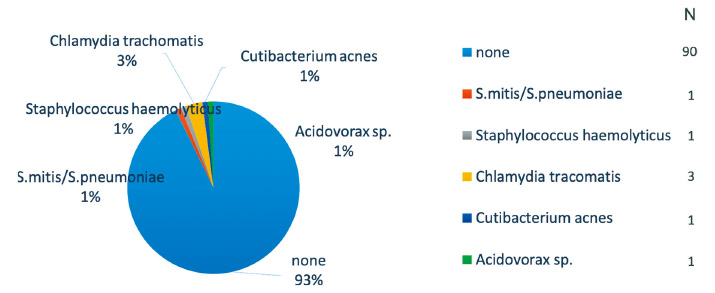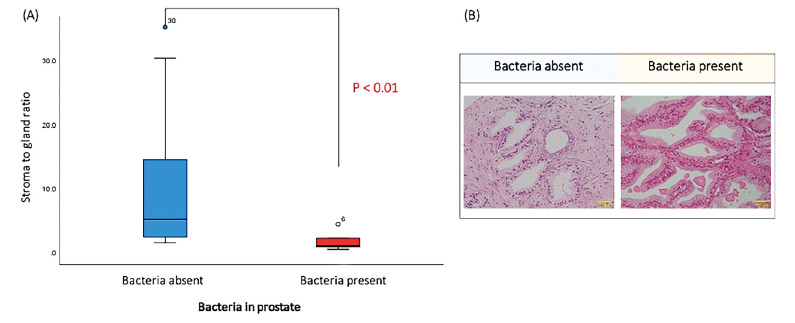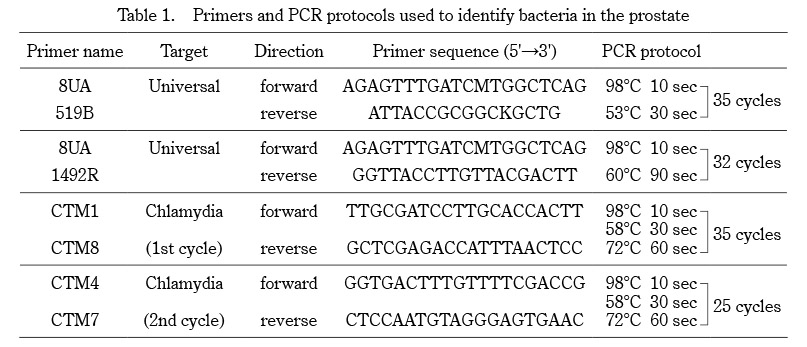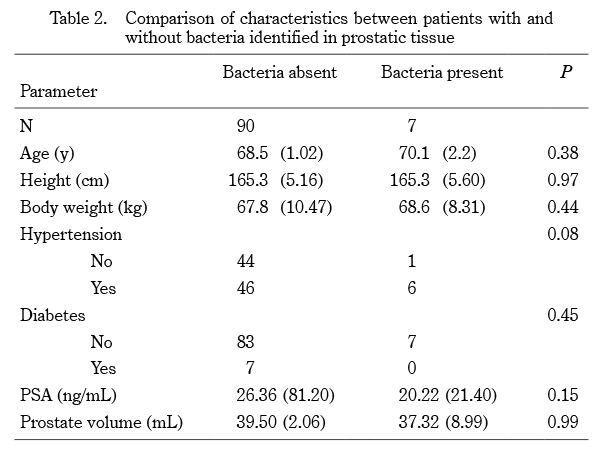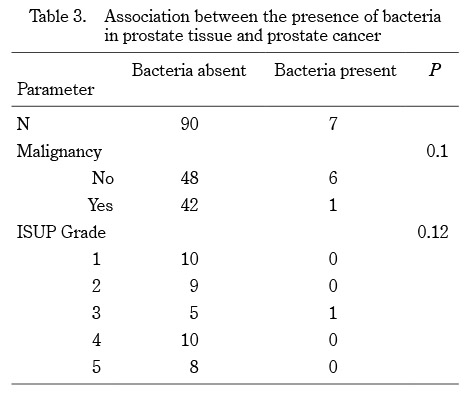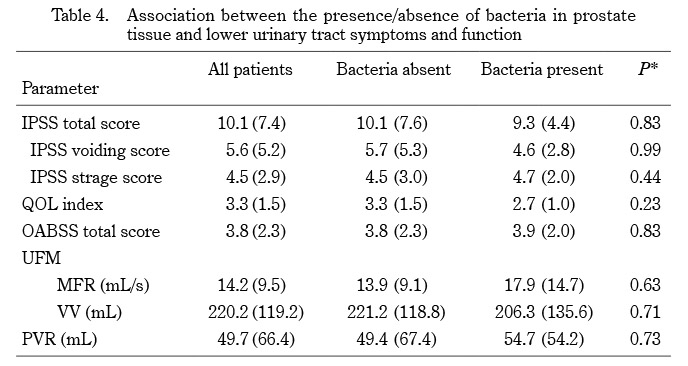Objective:To investigate the presence of bacteria in prostate tissue, and relationships between the bacteria and histopathological findings. Methods:Samples were collected from prostate biopsy patients with no obvious lower urinary tract symptoms (LUTS). Detection and identification of bacterial species in the prostate tissues were performed with PCR for 16SrDNA and DNA sequencing. Histopathology was also evaluated. LUTS and lower urinary tract function were assessed by questionnaires, uroflowmetry, and ultrasonography. Results:DNA was extracted from 97 prostate biopsies, with 5 bacterial species detected among samples from 7 patients (7.2%). The stroma-to-gland ratio in the prostate tissues from patients with bacteria was lower than in those without bacteria (p < 0.01). Glandular epithelial hyperplasia was also identified in the prostates harboring bacteria. International Prostate Symptom Score (IPSS), IPSS-quality of life (IPSS-QOL), Overactive Bladder Symptom Score (OABSS), maximum flow rate, urine volume by uroflowmetry, and post-voided residual urine were not significantly different when comparing patients with and without bacteria in their prostate samples. Conclusions:The present study demonstrated that 7.2% of men without obvious LUTS had bacteria in their prostate tissues. The presence of such bacteria might induce glandular hyperplasia and contribute to pathological changes in the early stages of benign prostate enlargement before affecting LUTS.
Abstract/References
Association between the presence of bacteria in prostate tissue and histopathology in biopsies from men not complaining of lower urinary tract symptoms
Ruriko Honda-Takinami, Junya Hata, Kanako Matsuoka, Seiji Hoshi, Tomoyuki Koguchi, Yuichi Sato, Hidenori Akaihata, Masao Kataoka, Soichiro Ogawa, Kyoko Nishiyama, Tatsuo Suzutani, Yoshiyuki Kojima
-
Ruriko Honda-Takinami
Department of Urology, Fukushima Medical University School of Medicine
-
Junya Hata
Department of Urology, Fukushima Medical University School of Medicine
-
Kanako Matsuoka
Department of Urology, Fukushima Medical University School of Medicine
-
Seiji Hoshi
Department of Urology, Fukushima Medical University School of Medicine
-
Tomoyuki Koguchi
Department of Urology, Fukushima Medical University School of Medicine
-
Yuichi Sato
Department of Urology, Fukushima Medical University School of Medicine
-
Hidenori Akaihata
Department of Urology, Fukushima Medical University School of Medicine
-
Masao Kataoka
Department of Urology, Fukushima Medical University School of Medicine
-
Soichiro Ogawa
Department of Urology, Fukushima Medical University School of Medicine
-
Kyoko Nishiyama
Department of Microbiology, Fukushima Medical University School of Medicine
-
Tatsuo Suzutani
Department of Microbiology, Fukushima Medical University School of Medicine
-
Yoshiyuki Kojima
Department of Urology, Fukushima Medical University School of Medicine
Abstract
References
1. Jain S, Samal AG, Das B, Pradhan B, Sahu N, Mohapatra D, et al. Escherichia coli, a common constituent of benign prostate hyperplasia-associated microbiota induces inflammation and DNA damage in prostate epithelial cells. Prostate, 80:1341-1352, 2020.
2. Bergh J, Marklund I, Thellenberg-Karlsson C, Grönberg H, Elgh F, Alexeyev OA. Detection of Escherichia coli 16S RNA and cytotoxic necrotizing factor 1 gene in benign prostate hyperplasia. Eur Urol, 51:457-462;discussion 62-63, 2007.
3. Ruetten H, Sandhu J, Mueller B, Wang P, Zhang HL, Wegner KA, et al. A uropathogenic E. coli UTI89 model of prostatic inflammation and collagen accumulation for use in studying aberrant collagen production in the prostate. Am J Physiol Renal Physiol, 320:F31-F46, 2021.
4. Wong L, Hutson PR, Bushman W. Prostatic inflammation induces fibrosis in a mouse model of chronic bacterial infection. PLoS One, 9:e100770, 2014.
5. Epstein JI, Egevad L, Amin MB, Delahunt B, Srigley JR, Humphrey PA. The 2014 International Society of Urological Pathology (ISUP) Consensus Conference on Gleason Grading of Prostatic Carcinoma:Definition of Grading Patterns and Proposal for a New Grading System. Am J Surg Pathol, 40:244-252, 2016.
12. Krieger JN, Riley DE, Vesella RL, Miner DC, Ross SO, Lange PH. Bacterial dna sequences in prostate tissue from patients with prostate cancer and chronic prostatitis. J Urol, 164:1221-1228, 2000.
13. Sfanos KS, Sauvageot J, Fedor HL, Dick JD, De Marzo AM, Isaacs WB. A molecular analysis of prokaryotic and viral DNA sequences in prostate tissue from patients with prostate cancer indicates the presence of multiple and diverse microorganisms. Prostate, 68:306-320, 2008.
14. Keay S, Zhang CO, Baldwin BR, Alexander RB. Polymerase chain reaction amplification of bacterial 16s rRNA genes in prostate biopsies from men without chronic prostatitis. Urology, 53:487-491, 1999.
16. Tolani MA, Suleiman A, Awaisu M, Abdulaziz MM, Lawal AT, Bello A. Acute urinary tract infection in patients with underlying benign prostatic hyperplasia and prostate cancer. Pan Afr Med J, 36:169, 2020.
17. Hochreiter WW, Duncan JL, Schaeffer AJ. Evaluation of the bacterial flora of the prostate using a 16S rRNA gene based polymerase chain reaction. J Urol, 163:127-130, 2000.
18. Pietilä J, Arvola I, Senius KE, Tuohimaa P. Weight, stroma to gland ratio, and mitotic activity of the human hyperplastic prostate. Invest Urol, 15:90-92, 1977.
19. Saito M, Ohmasa F, Tsounapi P, Inoue S, Dimitriadis F, Kinoshita Y, et al. Nicorandil ameliorates hypertension-related bladder dysfunction in the rat. Neurourol Urodyn, 31:695-701, 2012.
Figures (6)
